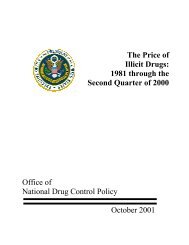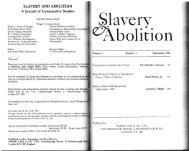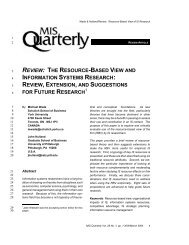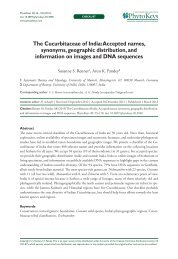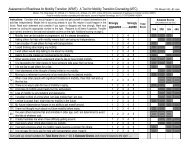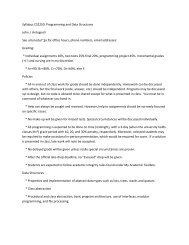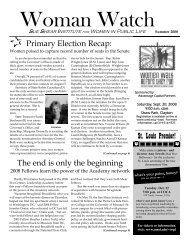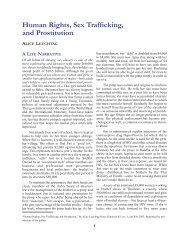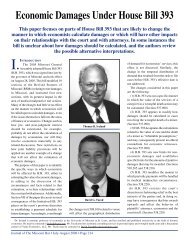an analysis of parole decision making using a sample of sex offenders
an analysis of parole decision making using a sample of sex offenders
an analysis of parole decision making using a sample of sex offenders
You also want an ePaper? Increase the reach of your titles
YUMPU automatically turns print PDFs into web optimized ePapers that Google loves.
8 HUEBNER F.DOC 11/1/2006 8:49:12 AM<br />
PAROLE DECISION MAKING 973<br />
RESULTS<br />
SAMPLE CHARACTERISTICS<br />
Descriptive statistics, by <strong>parole</strong> <strong>decision</strong> type, are presented in table 1.<br />
Similar to the total incarcerated population in the research state, the<br />
average male <strong>sex</strong>ual <strong>of</strong>fender was in his early 30s <strong>an</strong>d had not completed<br />
high school. In contrast, the racial composition <strong>of</strong> the <strong>sex</strong> <strong>of</strong>fender <strong>sample</strong><br />
is different from that <strong>of</strong> the total incarcerated population. The prison<br />
population in the research state is split nearly evenly between black <strong>an</strong>d<br />
white inmates, yet the majority <strong>of</strong> the <strong>sex</strong> <strong>of</strong>fender <strong>sample</strong> is white. For<br />
example, in the year 2003, 58 percent <strong>of</strong> the total state prison population<br />
<strong>an</strong>d 27 percent <strong>of</strong> the project <strong>sample</strong> were <strong>of</strong> minority race. Offenders<br />
were most <strong>of</strong>ten serving time for CSC 2 nd or 3 rd degree <strong>of</strong>fenses. Most<br />
<strong>of</strong>fenses involved penetration <strong>an</strong>d the majority <strong>of</strong> victims knew their<br />
assail<strong>an</strong>ts. In addition, <strong>of</strong>fenders had <strong>an</strong> average <strong>of</strong> two convictions prior<br />
to incarceration.<br />
Table 1. Sample Descriptive Statistics by Parole Decision, 2004<br />
Denied Parole<br />
(n = 233)<br />
Gr<strong>an</strong>ted Parole<br />
(n = 278)<br />
Total Sample<br />
(n = 511)<br />
Me<strong>an</strong> SD Me<strong>an</strong> SD Me<strong>an</strong> SD<br />
Individual controls<br />
Offender age * 34.84 12.99 31.69 10.43 33.76 11.99<br />
Minority race .27 .44 .27 .44 .27 .48<br />
Education * 10.28 1.59 10.77 1.71 10.56 1.66<br />
Time served * .33 .18 .23 .14 .28 .17<br />
Offender blameworthiness<br />
Multiple convictions * .16 .37 .06 .24 .11 .31<br />
CSC 2 nd degree * .43 .50 .34 .47 .38 .49<br />
CSC 3 rd degree .39 .49 .39 .49 .38 .49<br />
CSC 4 th degree .08 .27 .07 .25 .07 .26<br />
Sexual abuse .15 .35 .14 .35 .14 .35<br />
Community protection<br />
Parole readiness score * -1.80 7.74 1.66 5.34 .08 6.77<br />
Prior convictions * 2.19 2.14 1.79 1.82 1.98 1.98<br />
CSC convictions * .25 .67 .10 .49 .18 .59<br />
Penetration * .61 .49 .71 .45 .67 .47<br />
Younger victim * .36 .48 .19 .39 .27 .44<br />
Str<strong>an</strong>ger .06 .25 .05 .21 .06 .23<br />
Institutional misconduct * 3.48 4.18 1.23 1.83 2.26 3.32<br />
Note: Men in the gr<strong>an</strong>ted <strong>parole</strong> group were released on <strong>parole</strong> at some point<br />
during the study period. Men in the denied <strong>parole</strong> group had not received a<br />
positive <strong>parole</strong> <strong>decision</strong> during the study period. Data are current as <strong>of</strong> August,<br />
2004.<br />
* Groups are signific<strong>an</strong>tly different at p < .05




